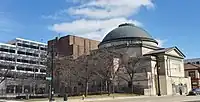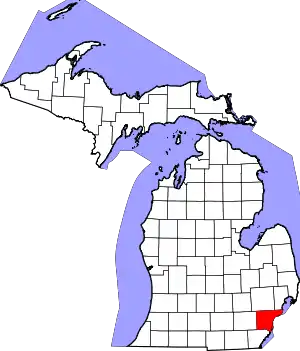Temple Beth-El | |
 | |
Interactive map | |
| Location | 3424 Woodward Avenue Detroit, Michigan |
|---|---|
| Coordinates | 42°20′45.92″N 83°3′24.86″W / 42.3460889°N 83.0569056°W |
| Built | 1902 |
| Architect | Albert Kahn; C. Howard Crane |
| Architectural style | Beaux-Arts |
| Part of | Midtown Woodward Historic District (ID08001106) |
| MPS | Religious Structures of Woodward Ave. TR |
| NRHP reference No. | 82002911[1] |
| Significant dates | |
| Added to NRHP | August 3, 1982 |
| Designated CP | November 26, 2008 |
The Bonstelle Theatre is a theater and former synagogue owned by Wayne State University, located at 3424 Woodward Avenue (the southeast corner of Woodward and Eliot) in the Midtown Woodward Historic District of Detroit, Michigan.[2] It was built in 1902 as the Temple Beth-El, and was listed on the National Register of Historic Places in 1982.[1] As of 2023, the Bonstelle is planned to be renovated and integrated into a newly-constructed hotel.[3][4]
Construction
When Rabbi Leo M. Franklin first began leading services at Detroit's Temple Beth El in 1899, he felt that the construction of a new temple building on Detroit's "Piety Row" stretch of Woodward would increase the visibility and prestige of Detroit's Jewish community.[2] Accordingly, in October 1900, the congregation held a special meeting at which it was decided to build a new temple. The congregation purchased a site for the new temple in April of the next year and engaged member Albert Kahn to design the structure. Groundbreaking took place on November 25, 1901, with the ceremonial cornerstone laid on April 23, 1902. The first services were held in the chapel on January 24, 1903, and the formal dedication was held on September 18–19 of the same year.[5]
Building
The temple is a Beaux-Arts structure influenced primarily by Roman and Greek temples. Architect Albert Kahn's exterior design for Temple Beth-El has been compared closely to the Pantheon in Rome.[6] There is a prominent dome over the main area of the temple, with gabled wings on the north and south. A pedimented extension on the front once extended into a porch; the front section of the building was lost when the city widened Woodward Avenue in 1936.[2]
Later use
When the Temple Beth El congregation constructed a new building farther north along Woodward in 1922, they sold the building at Woodward and Eliot to Jessie Bonstelle for $500,000.[7] Bonstelle hired architect C. Howard Crane to convert the building into a theater, and named the resulting building the Bonstelle Playhouse.[7] Myron G. Barlow was reported to be responsible for directing interior decoration in "Italian style."[8] In 1928, the Bonstelle Playhouse became the Detroit Civic Theatre, and in the 1930s, the Mayfair Motion Picture Theater. In 1951, Wayne State University rented the facility as a performance space for its theater company, and purchased it outright in 1956, renaming it the Bonstelle Theatre in honor of Jessie Bonstelle.
In 2019, the University reached an agreement to lease the theatre to Detroit-based development firm The Roxbury Group. The Bonstelle is planned to be renovated and integrated into an adjacent hotel by AC Hotels, which is expected to open in 2024.[3] The Bonstelle was expected to host Mary Poppins as its final performance in April 2020, which was cancelled due to the COVID-19 pandemic.[9] As a result, the final performance by Wayne State University in the Bonstelle was A Christmas Carol in December 2019. Wayne State University's theater performances are now produced and performed at the newly constructed Hilberry Gateway.[10]
Gallery
 Temple Beth El, c. 1905
Temple Beth El, c. 1905 Jessie Bonstelle in 1908
Jessie Bonstelle in 1908 The Bonstelle Theatre in 2008
The Bonstelle Theatre in 2008 The Bonstelle in 2023, after its closure, with the site of the future hotel to the left
The Bonstelle in 2023, after its closure, with the site of the future hotel to the left
See also
References
- 1 2 "National Register Information System". National Register of Historic Places. National Park Service. January 23, 2007.
- 1 2 3 Temple Beth-El Archived 2013-10-02 at the Wayback Machine from Detroit 1701.org.
- 1 2 Pinho, Kirk (March 20, 2019). "Roxbury's Bonstelle Theatre lease OK'd as part of 12-story West Elm boutique hotel project". Crain's Detroit Business. Archived from the original on March 21, 2019.
- ↑ Hernandez, Susana (July 9, 2018). "WSU to decommission historical Bonstelle Theatre". The South End.
- ↑ Katz, Irving I.; Jacob Rader Marcus (1955). The Beth El Story: With a History of Jews in Michigan Before 1850. Detroit: Wayne State University Press. pp. 96–101. ISBN 9780783735849.
- ↑ Beaudoen 2005, p. 22.
- 1 2 "Bonstelle: Celebrating 100 Years of History" (Press release). Wayne State University. October 23, 2003. Archived from the original on September 1, 2006.
- ↑ "Barlow to Direct Work". Detroit Free Press. Detroit, Michigan. June 22, 1924. p. 3.
The world-famous artist, Myron Barlow, will arrive in Detroit this fall from Europe, personally to direct the decoration of the theater's interior in the Italian style.
- ↑ "An important update from the Department of Theatre and Dance". Wayne State University. March 16, 2020. Retrieved February 27, 2023.
- ↑ "Theatre and Dance at Wayne Announces the Last Full Season in the Hilberry Theatre Before Moving to Gateway Performing Arts Center" (Press release). Wayne State University. December 13, 2019. Retrieved May 31, 2020.
Further reading
- Hill, Eric J. and John Gallagher (2002). AIA Detroit: The American Institute of Architects Guide to Detroit Architecture. Wayne State University Press. ISBN 0-8143-3120-3.
- Beaudoen, Marlise (2005). "Adaptation, Synthesis, and Survival: The Ancient Renaissance Antecedents of Albert Kahn's Temple Beth El". In Sobocinski, Melanie Grunow (ed.). Detroit and Rome: building on the past. Dearborn: Alfred Berkowitz Gallery, University of Michigan–Dearborn. pp. 17–27. ISBN 0933691092.
External links
- Bonstelle Theatre - Wayne State University
- Photographs from the Rabbi Leo M. Franklin archives: these include photographs c. 1903 - 1922 of both the interior and exterior of the structure.


